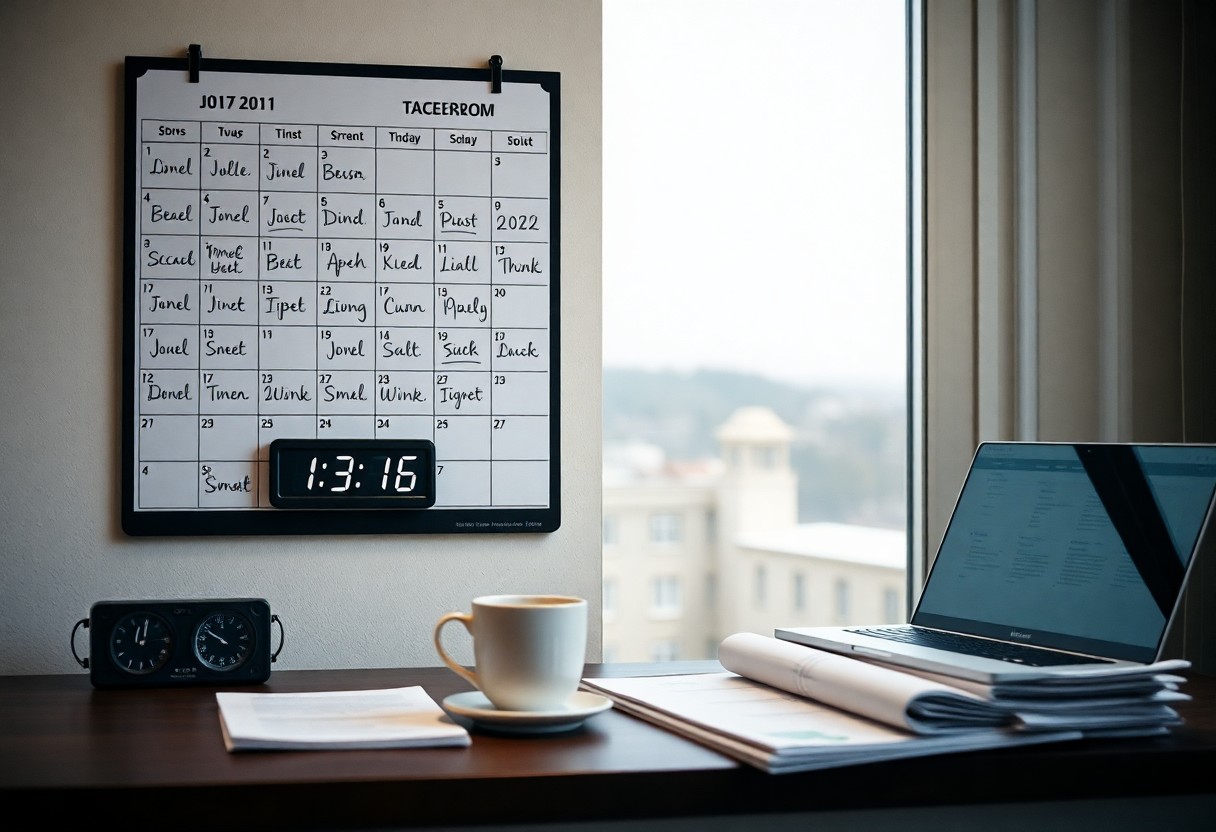There’s a powerful way to enhance your productivity by mastering the organization of your day. By implementing effective strategies, you can streamline your tasks and prioritize your goals, allowing you to seize control of your time. This guide will provide you with actionable steps to structure your day, minimize distractions, and maximize your efficiency, ensuring you achieve more without feeling overwhelmed.
Designing Your Ideal Daily Framework
Creating a personalized daily framework is important for aligning your activities with your peak productivity. This involves structuring your day around your unique rhythms, preferences, and responsibilities. Start by identifying your most important tasks and how they fit into your daily availability. A well-organized framework allows you to focus on what truly matters, helping you maximize efficiency and maintain motivation throughout the day. Your productive hours are the times during the day when you feel most alert and focused. Identifying these hours requires observation—experiment with different work periods and assess your performance. For some, mornings spark creativity, while others may peak in the afternoon or evening. Time blocking helps you allocate specific periods for distinct tasks, minimizing distractions and enhancing focus. By segmenting your day into manageable blocks, you ensure that you’re dedicating adequate time for deep work, meetings, and breaks, thus preventing burnout. Consider using a digital calendar or planner to implement time blocks effectively. Reserve the first two hours of your day for focused work on priority projects, followed by a break to recharge. Allocate time for emails in one block, limiting these interruptions to foster deeper concentration on your prime tasks.
Prioritization Techniques That Drive Results
Effective prioritization transforms your to-do list into a strategic roadmap, helping you focus on what truly matters. By employing various techniques, you can ensure that your daily efforts align with your long-term goals and yield maximum outcomes. The Eisenhower Matrix categorizes tasks into four quadrants based on urgency and importance. By distinguishing between what needs immediate attention and what is merely pressing, you can allocate your time and energy wisely. For instance, handling a client crisis (urgent and important) takes priority over answering a non-urgent email (not important), guiding your daily actions effectively. The ABCDE Method offers a simple way to categorize your tasks based on their importance to your goals. By assigning each task a letter from A (most important) to E (least important), you create a clear outline for your day. “A” tasks are those that contribute significantly to your objectives, such as meeting deadlines or completing major projects. “B” tasks are important but not emergency-related, while “C” tasks are nice to do but yield minimal impact. “D” tasks can be delegated, and “E” tasks should be eliminated altogether.

The Art of Scheduling: Balancing Work and Breaks
Effective scheduling requires a balance between focused work and necessary breaks, ensuring that both productivity and mental well-being thrive. Crafting a daily plan allows you to allocate dedicated time blocks for tasks while intentionally scheduling pauses to rejuvenate your mind. The Pomodoro Technique segments your work into focused intervals, usually 25 minutes, followed by a 5-minute break. This method helps you maintain high levels of concentration while preventing fatigue. Incorporating strategic breaks into your workflow enhances overall productivity. Schedule longer breaks, approximately 15-30 minutes, after several cycles of focused work, allowing time for physical movement, hydration, or meditation. Studies show that taking regular breaks can increase productivity by up to 30%.
Overcoming Common Disruptors to Productivity
Identifying and tackling the factors that disrupt your productivity is vital for creating a streamlined workflow. Common obstacles include digital distractions, unplanned interruptions, and ineffective multitasking. Your productivity can be significantly hampered by hidden distractions that steal your time. These time thieves often include excessive social media use, frequent email checks, or unnecessary meetings. Creating a space dedicated to focused work significantly enhances your productivity. You can establish operational boundaries by setting specific work hours, minimizing open channels of communication during these periods, and designating areas free from distractions. To fortify your boundaries, consider implementing tactics such as using noise-canceling headphones, employing structured work time, and utilizing applications that block distracting websites.
Measuring and Adjusting: Fine-Tuning Your Process
Steady assessment of your productivity strategies leads to greater efficiency. Regularly reflect on accomplishments and setbacks, identifying what strategies yield the best results. Set specific metrics, like tasks completed per hour or projects finished per week, to quantify your productivity. Track your time and achievements to unveil recurring patterns in your productivity. By reviewing your work logs, you can identify peak performance periods during the day or week, as well as activities that hinder your progress. Flexibility in your schedule allows for real-time responsiveness to changing needs. Regularly adjust time allocations based on what your analysis reveals. If certain tasks consistently take longer than expected, reconsider their priority or break them into smaller, manageable chunks.
Summing up
With these considerations, you can enhance your daily productivity by systematically organizing your time. Prioritizing tasks, setting specific goals, and utilizing tools like calendars or apps will help you stay focused and efficient. By designing a structured routine and allowing for breaks, you not only manage distractions but also sustain your energy levels throughout the day. Implementing these strategies will empower you to take control of your time, leading to increased output and a more fulfilling work life.


